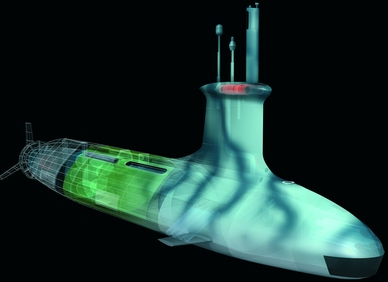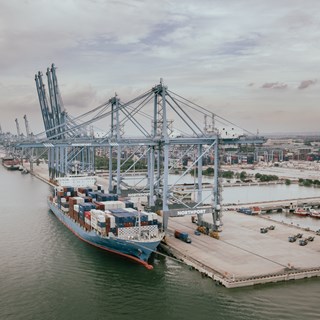Submarines are designed for a service life of more than 25 years. They, therefore, need to be prepared to meet the needs of tomorrow and today, which not only means a flexible operational capability but also implies increased importance on sustainability and climate resilience in design.
Although submarines, through low signature requirements, often present a lower environmental footprint than their larger ship counterparts, a considerable concerted effort is still required to ensure the platform is environmentally sustainable throughout its entire life: from concept to end-of-life disposal.
At RINA'S 'Warship 2021: Future Technologies in Naval Submarines' conference, Lisa Hammock, a Senior Environmental Consultant at BMT, explored the key drivers and factors behind environmental sustainability in submarine design, with examples demonstrating how sustainable principles may be used to improve the environmental impact of a platform, without compromising the mission and whilst enhancing performance. It also discussed the role of teamwork in achieving this goal, including how designers, customers, shipyards and suppliers can all work together to maximise the benefits of a sustainable submarine design.
Various technologies are available to reduce a platform's immediate environmental impact. However, a designer must assess the environmental impact over the whole lifecycle to be environmentally sustainable.
Sustainability in Defence
An essential consideration for defence activities and assets is the ability to remain operationally effective. But this can be achieved in synergy with environmental sustainability. In fact, following a sustainable approach to asset design, procurement operation, and disposal, can also provide opportunities for improvements and more efficient operation throughout the platform lifecycle, which was recognised in the recently published Ministry of Defence Climate Change and Sustainability Strategic Approach:
"In widening and embedding sustainability ,we will look at our impact on the environment in a whole different way. This will reveal opportunities for building greater resilience and creating new types of partnership."
Climate change has and will continue to impact how defence, as a whole, protects, operates and fights. All sectors of defence have a part to play in reducing the contribution to climate change and biodiversity loss.
The asset lifecycle
The asset lifecycle follows the path of Concept, Assessment, Demonstration, Manufacture, In Service, and Disposal (CADMID ). Using this lifecycle framework allows the designer to assess and minimise the overall impact on the environment. It applies equally to components, equipment, systems and platforms.
By undertaking an Environmental Impact Assessment (EIA) early in the lifecycle, the total environmental impact of the platform can be understood and mitigated. The effects of a programme's production, transportation and disposal are often overlooked yet are efficiently designed during the early phases and by reassessing throughout the lifecycle, rather than attempting to remedy the impacts of equipment or platforms once in service. The design may be optimised throughout its life by starting with the end.
An EIA should be conducted at critical milestones throughout the design process (for example, during design reviews and when a fundamental design change is made) to assess the platform's impact at each phase of its lifecycle. The cost of designing mitigations at the front end is almost always lower and more straightforward than attempting to rectify later.
Refrigerant systems are an excellent example of this. The 2014 EU F-Gas Regulation (517/2014) controls the use and emissions of F-Gases. Hydrofluorocarbons (HFCs) will be phased down in the UK to achieve a reduction of 79% by 2030, compared with average use between 2009 - 2012. Systems and equipment suitable for lower Global Warming Potential (GWP) refrigerants can differ significantly from those used in previous designs and can be complex and expensive to retrofit. Given the length of the CADMID cycle of a platform, consideration should be given to the likely availability of refrigerants during the platform's life to design out obsolescence issues or increased costs at a later stage.
It may be reasonably assumed that some of the common refrigerants being used today with higher GWP will be phased out during the lifecycle of a platform, which can lead to increased operating costs before the refrigerant becomes unavailable during the phase-out period. The financial and environmental costs of retrofitting a different system during the platform's life must be considered at the front end of the CADMID cycle to allow the designer to investigate alternative refrigerants and systems, to future-proof the design.
Many designers are now considering ammonia and CO2 as viable alternatives to higher GWP refrigerants. Ammonia and CO2 have inherent safety hazards; however these hazards may be mitigated early in the platform design phase, making these options feasible. When selecting these options, it is important to investigate the supply chain of the ammonia or CO2: historically, the production of ammonia involved high temperatures and pressures, and was a very energy intensive process.
The traditional Haber-Bosch method of producing ammonia contributes around 1% of global Greenhouse Gas (GHG) emissions (Brown, 2016). However, greener ways of ammonia production are in development, which could improve its overall carbon footprint, make it a more sustainable product, and have a lower direct environmental impact.
Similar supply chain analysis should be undertaken when considering any system design or design change, including future fuel selections. The further-reaching ecological impact of the platform may be reduced by Working closely with suppliers and shipyards to reduce the environmental impact throughout the supply and production chains.
Water treatment streams
There are elements that the designer might consider when designing systems to enable the end user to operate the platform in a more environmentally sustainable manner during the in-service part of the platform lifecycle. Bilge management is one area where the system's design may encourage good operating practices. Two types of bilge water accumulate on ships and submarines: clean and oily.
Discharge of oily water is regulated under MARPOL Annex I (IMO, 1983). Bilge water with an oil content greater than 15 parts per million (ppm) shall not be discharged overboard. From a mission perspective, a submarine could be compromised by oil sheen on the water surface by removing overboard bilge water with oil content. Therefore, effective bilge management is essential for a torpedo from the perspective of environmental sustainability and operational sustainability.
Designing for a dry bilge concept, for example, involves the piping designer routing clean drainages directly into small collecting tanks in the bilge. Developing this from the start means that the contents of these small tanks are guaranteed to be oil-free, so there is no risk of compromising the environment or the mission when discharged. Because the remaining bilge water with potential oil content will be a smaller volume, the designer will have increased options for treatment or storage solutions.
Waste not, want not
Another example of using the design process to instil sustainable practices during the in-service phase is reducing wasted energy. When designing exothermic processes, designers should consider the possibilities of harnessing waste heat. Waste heat recovery systems do not have to be large and, when created from an early stage, may be easily integrated into a compact system design. Waste heat may be used for various applications, such as heating water or spaces. This careful use of energy is particularly applicable to diesel-powered submarines. In addition to energy recovery, a mindset to reduce energy consumption on board is also essential. The responsibility for sustainable submarine operations belongs to everyone onboard and the design and procurement teams. Switching off lights and non-essential equipment will help in the overall energy savings. Energy consumption reduction strategies in operation are also beneficial for the mission and the environment: operational sustainability and environmental sustainability often work together.
For the designer: low-energy equipment may be designed. By designing sustainably from the front end, improvements to the maintainability of equipment and, therefore, operations are often also improved. Low-energy lighting, reduced-flow shower heads, low-flush toilets and treated grey water reuse onboard for non-potable purposes are all ways to create in a manner that encourages environmentally sustainable operations in-service.
Regarding nuclear-powered submarines, considering the whole lifecycle provides a broader understanding of the 'hidden' environmental impact of nuclear power: the mining and processing of uranium and the radioactive waste handling should be considered when assessing the overall environmental impact of the platform. Whilst atomic energy is often considered 'clean' and 'free' in ecological terms; it should still be used mindfully. When using power onboard a submarine, the overall environmental ·cost' per kW of energy should be kept in mind.
Starting with the end in mind
An important, yet often overlooked, part of the lifecycle is disposal. Disposal impacts are evident throughout the life of the platform. There are operational wastes generated from product or equipment packaging and waste generated by personnel. Waste is produced during design changes when older equipment is removed and in the packaging of new equipment to replace it. Finally, waste is generated at the end of the platform lifecycle when the platform and its assets are removed from service.
Operational waste can be significantly reduced through careful analysis of the supply chain and working closely with suppliers. Increasing numbers of production companies are now looking at their impacts on the environment and sustainable production. Many are finding ways to reduce the volumes of packaging and recyclable packaging. Selecting suppliers with sustainable credentials and working with suppliers and manufacturers to maintain and improve these credentials will reduce the waste associated with the platform.
Operational waste should always be separated to allow recycling when disposed of ashore. But the responsibility does not end there: the waste contractor should also be carefully selected for their 'green' credentials to ensure that the waste generated by the platform will be handled sustainably.
Some inherently difficult wastes are generated onboard a platform, which are difficult to store safely during a mission. Food waste and, where women are present onboard, sanitary waste presents a health hazard if stored incorrectly. When considered from the initial design phase, several solutions to reduced waste production: from chilled storage to dehydrators and auto-gasification units, which produce an inert, compact by-product for standard storage and landing ashore. More recent waste handling technologies are tight and quiet: making them ideal alternatives for submarines.
Submarine endurance is a crucial driver of operational effectiveness, and waste storage may be a limiting factor. By considering the whole lifecycle of waste on the platform, such as reducing the packaging of consumables to allow more stores or processing the waste to minimise its stored volume onboard safely, it may be possible to extend patrol length.
By assessing the volumes and types of waste anticipated at an early design phase and carefully selecting the most appropriate equipment for the type and volume of waste, sufficient space may be allocated from the outset to provide a suitable solution.
Ultimate disposal of the platform and onboard equipment should be considered throughout the entire CADMID cycle of the forum. Whether equipment is being procured in the design phase or as a design change part way through the platform's life, consideration should be given to how the materials will be handled at the platform or equipment end-of-life.
The Sustainable MOD Strategy Waste Management 2015 -2025 follows the waste hierarchy set out in the European Waste Framework Directive, as transposed into UK law by The Waste (Circular Economy) (Amendment) Regulations 2020. This hierarchy declares the highest priority is the prevention of waste, followed by reuse and recycle. These elements should be explored with prospective suppliers to ensure that sustainable disposal is planned for at an early stage.
As well as designing for reduced waste and reusable or recyclable materials, the impact of waste should also be considered. Whilst toxic materials are inherently restricted onboard a submarine, some materials are hazardous to the environment or require energy-intensive processes to recycle or decommission. Where these materials cannot be avoided, they must be documented, along with volumes and locations, and a plan put in place for handling their disposal. By avoiding using such materials, the overall environmental footprint of the platform is improved.
Creating a disposal plan early in the design phase and maintaining the program throughout the lifecycle will ensure a clear picture of waste management and reduce the amount of waste consigned to disposal processes, which is increasingly crucial for nuclear-powered submarines and require a coherent strategy for managing laid-up subs. The security aspects of components and equipment should also be considered at the design phase to ensure that any security restrictions upon recycling/reuse are included in the disposal plan. In particular, the handling and storage of High-Level Nuclear Waste.
Conclusion
Environmental sustainability involves a holistic view of the platform across its lifecycle. It is about a mindset shift in a submarine's design, operation and disposal. Many systems and equipment are available to reduce a platform's environmental impact. However, often these options are not practicable for installation onboard a submarine due to space constraints, noise restrictions, weight considerations and atmospheric conditions.
Elements of the platform requiring environmental impact mitigation can be reduced by design, resulting in a selection of environmental protection equipment more suitable for the submarine environment.
It is possible to reduce the environmental impact of a submarine without compromising its mission capability. Indeed, in many of the examples cited in this paper, implementing sustainability practices at the front end of the design process is also beneficial to operational effectiveness.
Article courtesy of Warship Technology July/Aug 2021 edition. An edited version of the paper presented at RINA'S 'Warship 2021: Future Technologies in Naval Submarines' conference by Lisa Hammock, a Senior Environmental Consultant at BMT.







